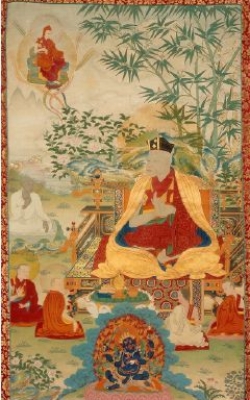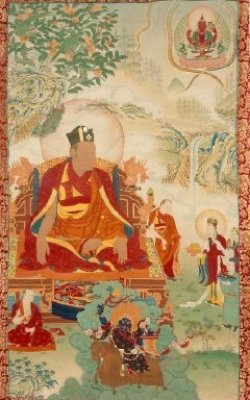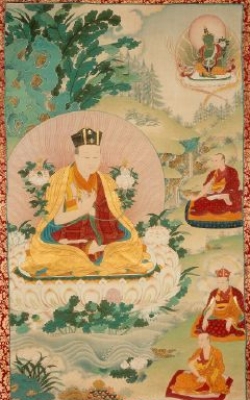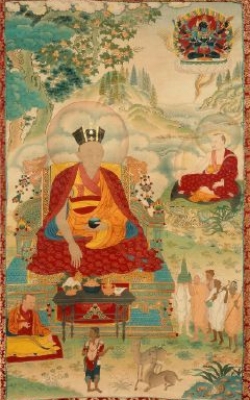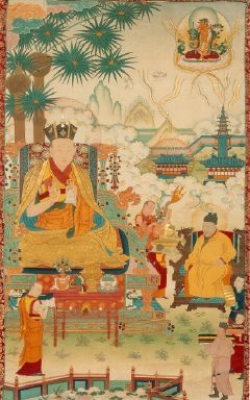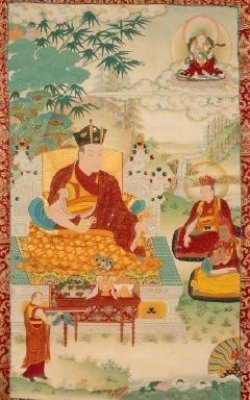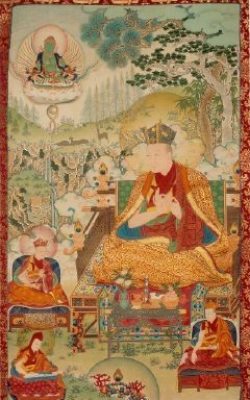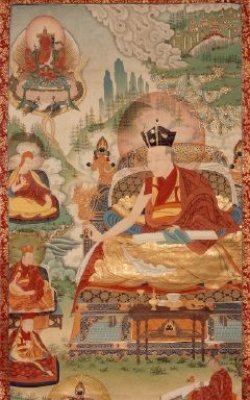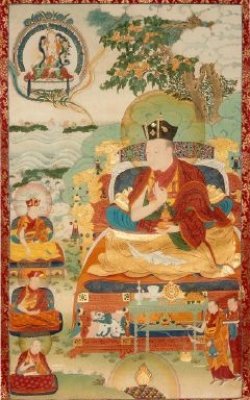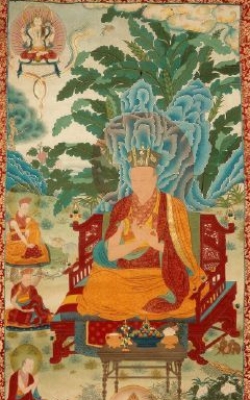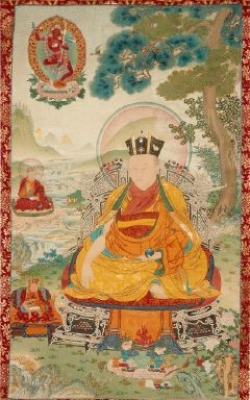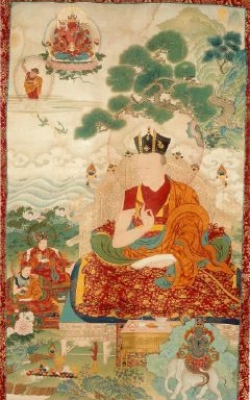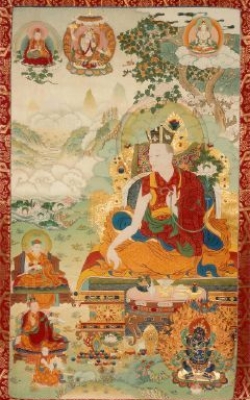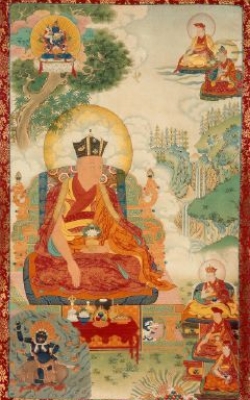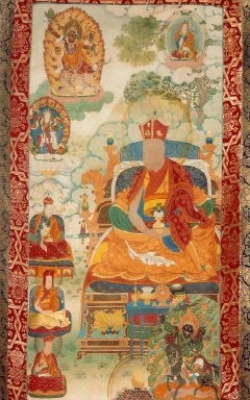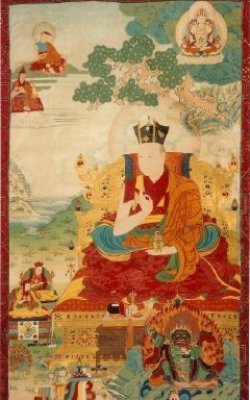Karmapa IV - Rolpay Dorje
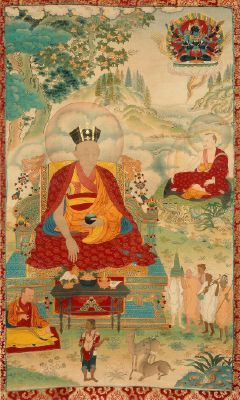
THE IVth KARMAPA
(1340 - 1383)
During the pregnancy of Rolpe Dorje’s mother many auspicious symbols occurred in her dreams, indicating the birth of an incarnate guru. On the eighth day of the third month of the year of the Iron Dragon (1 340 C.E.) Karmapa Rolpe Dorje was born. The sounds of the six-syllable mantra were heard on the lips of the baby and a beautiful fragrance issued from the body.
As a young child, Rolpe Dorje frequently displayed his remarkable abilities. At the age of three he declared: “I am Karma Pakshi. Many of my students are here and so I have come." He spontaneously sat in the position of Amitābha and told his mother that the position was one in which he had been seated in her womb.
At the age of six the young prodigy, on being questioned about his previous lives. replied, "l am Dusum Khyenpa and Karma Pakshi. I went to China and began to pacify the Mongol armies, am the one who watched from the clouds. My guru is emptiness and I am your guru. Now I possess three emanations. One is with the bodhisattva Ratnamati. One dwells in the spiritual environment of Buddha Aksobhya and I am the third. At the moment you may doubt me but soon this will pass. You yourself are my students"
Subsequently Gon Gyalwa, who acted as one of Rolpe Dorje's tutors, questioned the boy about his incarnation as Rangjung Dorje saying, "Karmapa said he would live to be the age of eighty-four, but he died at fifty-five. What happened?" Rolpe Dorje replied. "Fewer people were religious and their way of life was very negative. This upset Rangjung Dorie and caused him to lose his wish to remain here." Gon Gyalwa further questioned the young incarnation about why people had seen his face in the full moon on the night following his death, the young boy answered by saying: "Rangjung Dorje had limitless compassion and his students had strong devotion. These two causes coincided and produced the vision of his appearance in the moon."
The young Rolpe Dorje had many spontaneous visionary experiences. which symbolized the natural unfoldment of his own spirituality. At one time when he fell ill with influenza. he entered meditation upon Bhaisajyaguru, the buddha-embodiment of medicine. In this meditation he drank from the crystal water bowl which Bhaisajyaguru, extended to him, Immediately, his sickness passed, Rolpe Dorje experienced the omnipresence of the buddha-nature throughout being. It is said that he was able to see the different buddha "families" in his own veins and to see the spiritual environments of buddhas in one atom. On one occasion he manifested ten different forms in which he listened to ten different teachings in ten different spiritual environments. These experiences reflected Rolpe Dorje’s realization of the interpretation of buddha-nature in all experience and phenomena.
The awakening of the young Karmapa's innate compassion was symbolized by his visionary descent to hell in the form of Avalokiteshvara. There, he controlled the sufferings brought about by intense aggression. With the rain of his compassion he was able to extinguish the fires of hatred and restore all the beings trapped in their environment to basic sanity.
The Karmapa child was like a garuda, the mythical bird which hatches from the egg, complete full-grown. In his dreams he visited Uddhiyāna, land of the dākinis, where Vajrayogini gave him profound teachings in which, she told him: "Yours is a naturally unborn mind. Let meditation, visualization and recitation arise. Make offering prayers and tormas. By performing this practice for eight days, you will obtain the spiritual power of Vajrayogini.”
In other dreams Rolpe Dorje journeyed to the Potala spiritual environment. Here he perceived the mandala of Avalokiteshvara in its pure immediacy, which produced in him the realization of mahāmudrā. To express his understanding, Rolpe Dorie composed songs relating his visionary experiences. At the age of nine he began to study the teachings of the Kagyu and Nyingma traditions. During this period, it is said that Rolpe Dorie accomplished his studies with great ease, apparently having to exert very little effort, due to his inherent ability.
When Rolpe reached the age of thirteen he went to Central Tibet. On the way he passed Dak -lha Gampo, the monastery of Gampopa, which he saw as a Stupa made of jewels, surrounded by buddhas, bodhisattvas and saints. He composed a song in praise of the place to express his delight.
At Phagmo Dru monastery, Rolpe Dorje was welcomed by Tai Situ Changchub Gyaltsen, who became ruler of Tibet. From there he continued to Tsurphu, the principal monastery of the Karmapa Lamas. On his arrival he was inspired by a vision of Vajrayogini. In preparation for his monastic ordination Rolpe Dorje studied the vinaya texts, concerning religious discipline.
Then. at the age of fourteen he received ordination as a novice from Döndrup Pal Rinpoche. He was named Dharmakirti to confirm his entrance into the monastic life.
Döndrup Pal Rinpoche evoked in Karmapa a sense of the richness of Dusum Khyenpa’s transmission. In meditation he saw as many Dusum Khyenpas, as stars in the sky. Following this, Rolpe Dorje's spiritual practice concerned Amitābha, the embodiment of deathlessness. He entered a retreat in which, the significance of Amitābha teachings became completely clear to him, both through his meditation and his dreams.
Subsequently Rolpe Dorje invited the Nyingmapa scholar Gyalwa Yungtönpa to visit him. This teacher was the living lineage-holder of the Karma Kagyu "transmission," which he himself had received from Rangjung Dorje. On meeting Yungtönpa, a spontaneous understanding of the mandala of peaceful and wrathful deities arose in Rolpe Dorje. The old Scholar said, I am very old but Rangjung Dorje showed such kindness in teaching me, that I have come from afar. Now please tell me what you remember of your previous lives."
Karmapa Rolpe Dorje replied that he was not able to recall his life as Düsum Khyenpa very clearly and that he could only remember a little of his life as Rangjung Dorje. However, he emphasized that he recalled his life as Karma Pakshi perfectly. When he heard this, Yungtönpa was overcome with emotion and prostrated at his young student's feet.
Rolpe Dorje received an exhaustive range of teachings, especially Kagyu and Nyingma instructions from Lama Yungtönpa. At the age of eighteen, he was ordained a monk by the Abbot Döndrup Pal Rinpoche, During the same year Rolpe Dorje met the famous Sakya lama, Sonam Gyaltsen, from whom he received the empowerment of the red Avalokiteshvara. Each lama recognized the other's spiritual authority on their meeting.
The following year the Mongol Emperor Toghon Temur, who was anxious to restore his links with the Karmapa incarnations, invited Rolpe Dorje to his court. However; at that time Karmapa was engaged in a teaching tour of Tibet and was unable to go. When he returned to Tsurphu a second invitation arrived from Toghon Ternur in which the emperor wrote:
I am the emperor, the king of heaven. I have heard that you,
Karmapa Rolpe Dorje have been reborn for us and you now dwell in Tsurphu.
Therefore, with deep respect I ask you to remember your previous actions.
These degenerate times are full of many sufferings.
Consider these sufferings and the innate goodness of the people.
Please bestow on us the nectar of the dharma to make us joyful.
Now many beings are acting in the wrong way.
So please point to the right direction for them.
Please set forth from home.
Do not consider the difficulties of the journey nor your health but please come quickly! Buddha himself did not think of his own sufferings when he wished to benefit sentient beings.
Please come immediately.
When you arrive, we must both encourage the progress of Buddhadharma and the welfare of the people.
Please listen, great Lama Ralpe Dorje, as an Offering I am sending you shrine implements. one ingot of gold. three ingots of silver and eighteen rolls of silk brocade.
Sent from Tai-ya Tu, the residence of the emperor,
on the tenth day of the tenth month in the year of the Earth Monkey.
Karmapa began the long and difficult journey to Peking in the ninth month of the Earth Dog year, at the age of nineteen. He used much of his time on the journey in composing texts. When the party arrived in Shawo, the Mongol envoys suggested that fresh horses, yaks and bearers be requisitioned from the local populace. However, Rolpe Dorie said, "Please do not ask the people for anything I shall send and provide for all. One should never burden the people." Despite this, people responded to Karmapa’s compassionate concern and many offerings were made to him. Rolpe Dorje instructed the people in nonviolence and the development of a loving attitude. To those who were already engaged in meditation practice Rolpe Dorje gave the explanations of mahåmudra and the six doctrines. At this time Rolpe Dorje himself attained the realization of ati yoga, the most sublime of Nyingma teachings.
Rolpe Dorie’s journey lay through the area of Wu-t'ai Shan where he made a pilgrimage to the peaks of Manjushri. There he met five Indian yogins who presented him with a Buddha rūpa carved by Nāgārjuna. During this period Rolpe Dorje composed a series of songs dedicated to Manjushri.
Continuing with the journey; Karmapa was invited to visit the domain of Prince Sangha Sri. He held a short seminary there during which, he instructed both courtiers and members of the public. Rolpe Dorje was also able to help the local people by ending an invasion of locusts, which threatened to destroy the crops. As he passed through various tiny kingdoms, he pacified factional feuding and witnessed the signing of many treaties. He donated a great deal of his wealth to restore peace and construct monasteries. In his dharma activity at this time Rolpe Dorje was inspired by Yamāntaka, who embodies the indestructibility of buddhahood. Yamāntaka removed the obstructing hindrances to Karmapa's compassionate work.
Subsequently, Rolpe Dorje subdued the embodiments of the area's energy and in this way turned the area to Kagyu dharma. Another notable event from the journey was Rolpe Dorje's visit to the famous "magical" temple of Sakya Pandita.
In Minyak, Karmapa spread the dharma and arranged a pardon for a ruler who had rebelled against the Khan. His presence instilled in the people reverence for the non-violent way of life. Finally on the eighteenth day of the twelfth month of the year of the Iron Mouse, the party arrived at the palace of Tai-ya Tu, where Rolpe Dorje was feted by the emperor and empress. H appily enough the empress gave birth to a baby, a son Maitripāla, later the same month.
The commitment of the emperor to Kagyu dharma was evident and sincere and so Karmapa was able to instruct him in the vital triad of Kagyu teachings, namely Vajrayogini, the six doctrines of Naropa, and the mahāmudrā of Tilopa. Rolpe Dorje also gave the royal children a grounding in the basic precepts of Buddha and generally instructed the Chinese and Mongol peoples and the other ethnic minorities of the empire, in the religion and non-violence. As a present to his guru, the emperor freed all prisoners and excused his monks from court etiquette. During his stay in China the compassionate activity of Rolpe Dorje extended to curing the sick and combating harsh climatic conditions.
After three years work in China, it was revealed in a dream to Rolpe Dorje that the emperor's life would be short. This made him decide to return to Tibet, Toghon Temur was upset by this news and pleaded with his guru to stay, saying, "Before you came everything was costly. Now things are easily obtained. Please remain here so that we may spread dharma in the manner of Kublai Khan and Sakya Phakpa. Please think carefully. All the factions who opposed the emperor are now peaceful. I have a new son. You are a fortunate teacher."
Rolpe Dorje replied, "l, do not possess enough knowledge. It is better to cease pretending. What I can do is to bless emperors by invoking the principle of the three jewels and by teaching them. All my words have been written down. Now I must return to Tibet, Monks must go wherever they can benefit sentient beings. It is best not to be attached to any country." So, reluctantly the emperor let Rolpe Dorje go.
Karmapa departed in the first month of the Wood Tiger year. Again, his journey was spent working for the welfare of the inhabitants of the various areas through which he passed. Together with the Sakya lama, Lhachen Sonam Solo. he saved the lives of condemned prisoners. Then he travelled through Minyak, where he built a new monastery at Kora and spread the dharma.
Rolpe Dorje’s timetable on the journey revolved around meditation, teaching and welfare work. All the gifts that he himself received he gave to needy individuals or institutions. When the party reached the Kongjo area in north-eastern Tibet, it carne across a smallpox epidemic. On the night following Karmapai s arrival, people said that they could hear noises on the roof of his house. In the morning Rolpe Dorie said that he had brought the epidemic to an end by manifesting as a garuda to destroy the imbalances producing the smallpox. Karmapa expressed his surprise at people's claims to have heard the noises of the garuda because he said in actuality it was simply the activity of formless mind.
Rolpe Dorje had long been interested in Indian poetics. In Kongjo he had a dream in which Sarasvati, symbolic consort of Manjushri and embodiment of artistic energy, appeared to him. Sarasvati gave him a pot of yoghurt and told him to drink it. The morning following this dream Rolpe Dorje discovered he had a new-found ability to understand poetics.
Arriving in the Tsongkha area near Lake Kokonor, Karmapai s party was honoured by the local rulers. Rolpe Dorje gave teachings and distributed aid to the local inhabitants. At Lake Kokonor he composed his text, “Removing Erroneous Views” - ལྟ་བ་ཉིང་བསལ།
It was in this area that Rolpe Dorje met a young boy who was destined to have a profound effect on Buddhism. Tsongkhapa. He gave the boy lay ordination and the name Kunga Nyingpo. Karmapa predicted about the child that. "This is a holy child who will be of great benefit to people. Therefore, he is like a second Buddha come to Tibet."
At this time Princess Punyadhari of Minyak, one of Rolpe Dorje’s students, dreamt of a huge thangka of Sākyamuni Buddha, measuring eleven arm-spans from ear to ear. On hearing of this, Karmapa devised a method to realize her dream. He rode over a certain area of ground on horseback tracing the pattern of this image with his horse's hoofprints. The measurements of Buddha's figure traced in this manner were found to be perfect. Then the image was transferred to a huge piece of silk. In all, it took five hundred people thirteen months to complete the thangka, which also represented Manjushri and Maitreya on either side of Sākyamuni. On completion the thangka was blessed by Rolpe Dorje. During the ceremony, auspicious events occurred. Afterwards, Princess Punyadhari gave the thangka to her guru. Later the princess requested Karmapa’s counsel when her region was about to be invaded by a Mongol army. Rolpe Dorje, who had the perfect courage of non-violence, invoked the principle of wisdom and compassion and the invading army moved away from the region. The people were overjoyed. Rolpe Dorje stayed for three months during which time, the atmosphere was pervaded by love and kindness among mankind and all other creatures.
Karrmapa's extensive activity in both dharma and social welfare attracted jealousy from certain quarters. Conspiracies were plotted to harm Rolpe Dorje, but nothing significant ever came of them. Karmapa himself followed as strict a regimen in the camp - གར་ཆེན།, as in a settled monastery. From the time he awoke until nine in the morning, he performed his spiritual practices. From then until noon, he gave instructions in dharma. At noon he performed prostrations and walking meditation. Throughout the afternoon he practiced Avalokiteshvara meditation and in the evening, he studied or composed texts.
His nights were passed in the practice of dream yoga. Rolpe Dorje was in fact, a vegetarian and established this as the basic diet of his camp.
Although surrounded by intrigue and gossip he remained unaffected and impartial. In contrast to many religious luminaries, Rolpe Dorie did not display intense pleasure to financial sponsors, reserving this instead for good meditators. Wherever he went he worked assiduously for the welfare of others in any way possible. from building bridges to instruction in metaphysics. His career exemplified the qualities of a true bodhisattva and master of all facets of Buddha's teaching.
When Karmapa’s party arrived in the Nangchen principality, his indisposition caused much concern. However, he informed people that it was not yet time for him to die. He further said that he would die in a very open land with many deer and wild horses. "If I become ill in such a country, I will die” RoIpe Dorje declared, "so, do not lose any of my books.” Then the party travelled to Karma Gön monastery, where he gave teaching to the monks. Karmapa asked his students to bring some juniper wood on the next stages of the journey. He told them that it was the custom in China to use sandalwood or agaru on a funeral pyre for a respected person, but since Tibet did not have this kind of wood. they would have to use juniper wood. When the party reached Nakchu, one of the monks broke his hand. This was considered very inauspicious.
During this period, Rolpe Dorje spoke to his students and attendants about the viciousness of samsara and the widespread inability of people to follow dharma. He said, "Perhaps it is better to demonstrate the real nature of samsara, which is that everything is impermanent." One of his students, Rekarwa, realized that Karmapa was referring to his own imminent demise and pleaded with him not to pass away. However, everybody else in the camp laughed at Rekarwa.
Subsequently the Karmapa's party set up camp in the barren northern plains of Tibet. Inauspicious signs were observed in the camp and Karmapa himself made oblique comments upon them.
On the night of the full moon in the seventh month of the year of the Female Water Pig (1383 C.E.), Rolpe Dorie became sick. He gazed into space and recited the "Prayer of Samantabhadra." Then he meditated until just before sunrise, when he passed away. The moments his passing, were marked by strange atmospheric occurrences, which symbolized to people the dākas and dākinis greeting Rolpe Dorje. Many people throughout Tibet, who had personal connections with him, envisaged him in various personal manifestations at this time.
Rolpe Dorje's ashes were brought to Tsurphu monastery and enshrined as relics.
Among Karmapa Rolpe Dorje's principal students were Shamar Kachöd Wangpo, Drigung Chökyi Drakpa and Lobzang Drakpa Tsongkhapa.
Reproduced with permission of the Very Venerable Karma Thrinley Rinpoche




